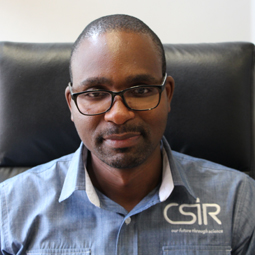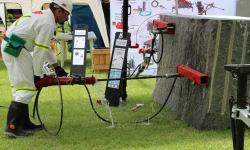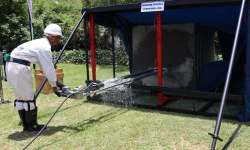South African mining industry to receive a boost with new high-tech rock drills
The Mandela Mining Precinct has unveiled two new rock drill prototypes developed by local innovators to enhance drilling operations, a significant move to advance the mining sector in the country.
The two high-tech prototype rock drills are set to reduce the exposure of operators to dangerous conditions and contribute to the aim of zero harm in mines. The prototypes are the culmination of an open innovation challenge launched in 2018 to develop a new rock drill for the South African mining industry.
The Mandela Mining Precinct has unveiled two new rock drill prototypes developed by local innovators to enhance drilling operations, a significant move to advance the mining sector in the country.
The two high-tech prototype rock drills are set to reduce the exposure of operators to dangerous conditions and contribute to the aim of zero harm in mines. The prototypes are the culmination of an open innovation challenge launched in 2018 to develop a new rock drill for the South African mining industry.
“The Isidingo Drill Design Challenge was launched with specific industry criteria detailing what is needed to improve efficiencies and reduce harm at the mining face, hence the name Isidingo,” explained Mandela Mining Precinct programme manager, Martin Pretorius.
Pretorius said that drilling is the most important part of the entire mining cycle and that the precinct saw the opportunity to develop a new locally manufactured rock drill for the industry.
The challenge was divided into three phases. The first phase entailed the introduction of a new and innovative rock-drill concept design; followed by the prototype construction associated with testing and monitoring. The third phase will entail manufacturing and underground performance testing.
“After a vigorous evaluation, two local companies, namely Novatek and HPE, were selected to develop prototypes, which were tested at the Mandela Mining Precinct,” said Pretorius, who is responsible for the Longevity of Current Mines programme.
“The tests successfully illustrated both company’s adherence to the primary criteria of enhancing the performance of the drill, reducing the exposure of operators to dangerous conditions and contributing to zero harm. The underground testing will take place at a mine to be announced closer to the time,” said Pretorius.
Both finalists found the balance between weight and robustness to be the most challenging.
“We needed the drill to be as light as possible, but still robust, and this was not easy,” said Novatek Managing Director, Julian Wills.
“Our strengths lie in hydropower and stope drilling rigs, and we are guided by the development of appropriate technology. This is part of our internal value system advocating for technology that must be appropriate for the type of mining, the infrastructure, the resources and the skills of the end user,” added Wills.
HPE Director, Ulrich Kienle, said that the development of their drill was a company-wide effort that adopted the HPE way of product development, whereby over a dozen concepts were considered and finally reduced to three viable ones.
A series of 3D-printed drills comprising 90 uniquely engineered parts assisted the team to solve the weight conundrum.
“An important aspect of the HPE way is that any concept must be safe, cost viable and meet all set KPIs. If those cannot be met, we do not have a product. We believe that being able to produce a high-performance and robust new drill is a game changer for our industry,” said Kienle.
HPE presented a versatile drilling system. “With our new offering, drilling is now possible in three ways, with a novel new hole guide puller, a stope drill jig, or in a conventional manner with a thrust leg,” said Kienle, adding that their drilling system is suitable for any angle and application. “Once the first hole has been drilled, the hole guide puller repeats the process and guarantees correct burden spacing, parallelism and in-line thrusting.”
Pet-named the Buffalo, Novatek’s drill incorporates a spring, shaped like a buffalo’s horns, and which embodies its strength, accuracy and speed. “What we delivered today meets some of the criteria really well. In our early tests, we encountered improvement on the noise levels, which we were not able to replicate, but we are eager to continue working thereon for the next phase,” said Wills.
South Africa’s mining RD&I is gaining momentum after a paucity, following the closure of COMRO. The Isidingo Drill Design Challenge is the first initiative for developing South African solutions to a South African problem, which the Mandela Mining Precinct is proud to pioneer.
“I find it encouraging that industry and government agencies are working together towards a common objective to reindustrialise South Africa, with emphasis on the cross sharing of ideas, and the Mandela Mining Precinct plays an important role in facilitating this,” said Wills.
ENDS
Enquiries:
Reyhana Mahomed
Communication Manager (Mandela Mining Precinct)
E-mail: rmahomed@csir.co.za
Tel: 073 473 0398
OR
David Mandaha
CSIR Media Relations Manager
Tel: 072 126 8910/012 841 3654
E-mail: dmandaha@csir.co.za
About the Mandela Mining Precinct
The Mandela Mining Precinct is a public-private collaboration between the Department of Science and Innovation and the Minerals Council of South Africa. It is working towards the revitalisation of mining research, development and innovation in South Africa to ensure the sustainability of the industry. The Mandela Mining Precinct is hosted and managed by the CSIR.




